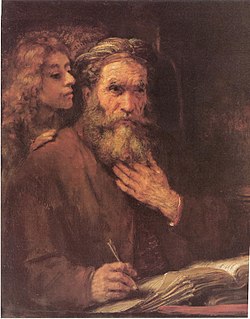Matthew the Apostle
Saint Matthew | |
|---|---|
 "The Evangelist Matthew Inspired by an Angel" by Rembrandt | |
| The Tax Collector | |
| Died | near Hierapolis or Ethiopia |
| Venerated in | Roman Catholic Church, Orthodox Church, Eastern Catholic Churches, Anglican Church, Lutheran Church, some other Protestant Churches |
| Major shrine | Salerno, Italy |
| Feast | September 21 (W), November 16 (E) |
| Attributes | tax collector |
| Patronage | Accountants, Salerno, Italy, and others, see [1] |
| Part of a series on |
| Christianity |
|---|
 |
Matthew the Evangelist (מתי, "Gift of the LORD", Standard Hebrew and Tiberian Hebrew: Mattay; Septuagint Greek: Ματθαίος, Matthaios) is an important Christian figure best known as one of Jesus' Twelve Apostles. His father's name is given as Alphaeus, which makes him a brother of another apostle, James, son of Alphaeus. He is traditionally believed to be the author of the Gospel of Matthew.
Very little about his life is certain. The Gospel of Matthew introduces him as a publican, or tax-collector, at Capernaum. He is called Levi in Luke (5:27). Although Mark calls him Matthew in his list of the Apostles, when recounting the story how the publican is called to be a disciple, he calls him Levi (2:14). Some explain this discrepancy by saying he initially was called Levi, then acquired the additional namesake of Matthew later in life. According to Luke's Gospel, the same day on which Jesus called him he made a "great feast" (Luke 5:29) to which he invited Jesus and his disciples. The last notice of him in the New Testament is in Acts 1:13. He is one of the few disciples mentioned by name in the apocryphal Gospel of Thomas, suggesting he was of more importance in the early church than surviving evidence indicates. Legend has it that he preached the gospel for a long time after the ascension and carried it all the way to Ethiopia where he was killed.
The time and manner of his death are unknown. Some traditions say that Matthew was martyred in Ethiopia. Others say that he was martyred in Hierapolis of Parthia. According to Epiphanius, Bishop of Cyprus, Matthew was martyred in Hierapolis, and Saint Matthias, who replaced Judas Iscariot among the Twelve, is the one who died in Ethiopia. Recently, there have been some controversial investigations into a 14th-century document assigning Matthew's burial site to a place called "Issyk-Kul."
His relics were carried to Campania, in the Diocese of Capaccio. Retrieved by Lombards, they were moved to Salerno, where they are currently kept in the Cathedral's crypt.
He is recognized as a saint in both the Roman Catholic and Eastern Orthodox churches. The Eastern Orthodox celebrate his feast day on November 16, whereas September 21 is observed in Latin churches.
Like the other three Evangelists, Matthew is often depicted in Christian art. His particular attribute is a winged man, a reference to the angel who is supposed to have dictated to him as he wrote. The three paintings of his life by Michelangelo Merisi (Caravaggio) in the church of San Luigi dei Francesi in Rome are among the landmarks of Western art.
"In the crypt (of the cathedral of San Matteo) is the sepulchre of San Matteo [St. Matthew], whose body, according to legend was brought to Salerno (Italy) in the 10th century."[1]
References
- ^ Encyclopaedia Britannica "Salerno". Chicago: Encyclopaedia Britannica, Inc. 1983. p. 807. 0-85229-400-X.
See also
-
Rembrandt's "The Evangelist Matthew Inspired by an Angel"
-
The calling of St. Matthew, by Hendrik ter Brugghen
-
Caravaggio, The Calling of Saint Matthew



